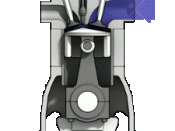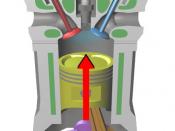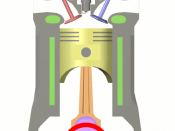What really makes a car go? There are many parts to an engine that are visible, like an alternator, starter, hoses, wires and a bunch of other things. But what is in the inside and how does it work? The process is really just a mixture of parts, moving in sync in a distinct pattern called the four-stoke cycle.
To understand the components of a four-stroke engine better, a little background information may be needed. 'In a gasoline engine, exhaust and intake manifolds (tunnels) and valve ports(inlets or outlets) are needed to supply air and fuel on the intake (first down) stroke of the cylinders, and to expel burned gases on the exhaust(second up) stroke. The ports are opened and closed at the proper times by the intake and exhaust valves, which close against the sides of the ports' (Doyle 128). The controlling of the valves start with a cam shaft. A cam shaft has lobes on it which are all shaped differently, but resemble an oval. On a camshaft lobe there rests a lifter. A lifter is cylinder shaped and pushes up on a push rod when the lobes are rotating. A push rod, which is connected to a rocker arm, then 'rocks' down on a spring that in turn pushes open a valve. This all happens due to the rotation of the camshaft which is geared to the crankshaft (which is connected to the pistons) which is all part of the four stroke cycle.
The four-stroke cycle starts with the intake stroke. On the intake stroke, the piston moves down from its top dead center or the farthest 'up' position creating a partial vacuum which draws in the fresh air-fuel mixture from the open intake valve. Think of the vacuum like a syringe with no needle. 'If...


